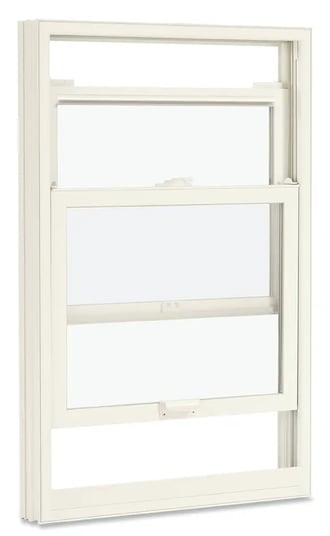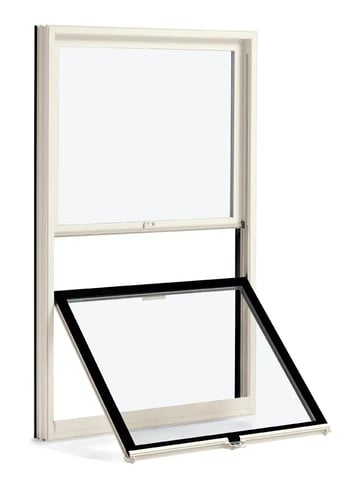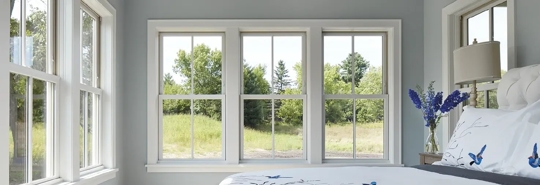When you think of the archetypal window, the image that comes to mind is probably the double-hung window. These windows are the most popular in America because they're simple, offer great airflow, and go with virtually any style, from classic to contemporary.
In this article, we'll talk about what distinguishes double-hung windows from other designs (like single-hung), their pros and cons, and what you should consider if you're looking to purchase them.
What Are Double-Hung Windows?

Double-hung windows feature two movable sashes (one on the top and one on the bottom) that each slide vertically. Homeowners love these windows because they are simple, have great airflow, and are versatile enough to work with all kinds of home designs, from classic to contemporary.
Pros of Double-Hung Windows
Double-Hung windows have two primary advantages over other windows, like single-hung, casement, or awning windows:
- Better Airflow: Double-hung windows offer unparalleled ventilation control. You can open the top sash to allow warm air to escape while cool air comes in through the bottom.
- Tilt-In Sashes for Easy Cleaning: One of the most convenient features of modern double-hung windows is the tilt-in sashes. This design allows you to tilt the sashes inward, making it easy to clean both the interior and exterior surfaces of the glass from inside your home. This eliminates the need for ladders or professional cleaning services, especially for windows on higher floors, saving you time and effort in maintaining sparkling clean windows.

Cons of Double-Hung Windows
While double-hung windows offer many benefits, it's also important to consider some potential drawbacks. Understanding these can help you make a well-informed decision for your home.
- Cost: One of the primary drawbacks of double-hung windows is their cost. Compared to single-hung windows, double-hung windows can be more expensive.
- Seal Longevity: Another potential issue with double-hung windows is the longevity of the window seals. Over time, the seals around the sashes can wear out or become damaged, especially with frequent use. When seals fail, they can allow air and moisture to leak into your home, reducing energy efficiency and potentially leading to other issues like condensation between the glass panes.
Signs It’s Time to Replace Your Double-Hung Windows
Even the best windows need replacement eventually. Here are some key indicators that it’s time to consider replacing your double-hung windows:
- Drafts: If you feel a noticeable draft near your windows, it’s a sign that the seals may have failed or the window frame has warped. Drafts can significantly impact your home’s energy efficiency and comfort.
- Difficulty Operating: Double-hung windows should open and close smoothly. If you’re struggling to move the sashes, it could indicate a problem with the window’s balance system or frame. Difficulty operating the windows can also pose a safety risk, especially in emergency situations.
- Visible Damage: Inspect your windows regularly for visible damage such as cracks in the glass, rotting wood, or deteriorating frames. These issues not only affect the window’s performance but can also lead to further damage to your home if not addressed promptly.
- Condensation Between Panes: If you notice condensation or fogging between the glass panes, it’s a clear sign that the seal has failed. This reduces the window’s insulating properties and can lead to higher energy bills.
How to Choose the Right Double-Hung Windows
Selecting the perfect double-hung windows for your home involves considering several factors, from material choices to energy efficiency and design preferences. Here’s a guide to help you make the best decision
Design Choices for Double-Hung Windows
Double-hung windows offer numerous customization options to suit your personal style and home’s architecture:
Grilles: Grilles add a decorative touch to your windows and can be customized in various patterns, such as colonial, prairie, or diamond. Choose between grilles-between-the-glass for easy cleaning or simulated divided lites for a more traditional look.
Colors: Most double-hung windows come in a range of exterior and interior color options. Select a color that complements your home’s exterior while matching your interior décor. Some manufacturers also offer custom color matching.
Hardware: The hardware on your windows, such as locks and handles, can enhance both functionality and aesthetics. Choose from different finishes, including brass, nickel, or bronze, to match your home’s style.
Material Options
Wood
Wooden double-hung windows offer a classic, timeless look that adds warmth and character to any home. They are highly customizable and can be painted or stained to match your interior and exterior décor. However, wood requires regular maintenance to prevent rot, warping, and insect damage.
Vinyl
Vinyl windows are a popular choice due to their affordability, low maintenance, and durability. They are resistant to moisture and do not require painting or staining. Vinyl is available in a variety of colors and finishes, but it may not offer the same aesthetic appeal as wood.
Fiberglass
Fiberglass windows combine the best of both worlds: the strength and durability of wood with the low maintenance of vinyl. They are highly energy-efficient and can be painted to match your home’s color scheme. While more expensive than vinyl, fiberglass windows last longer (50 years as opposed to 20-30), can be made to look just like real wood, and can be stained or painted.
Energy Ratings
When choosing double-hung windows, energy efficiency is a crucial consideration. Look for the following markers to ensure you’re getting energy-efficient windows:
- Energy Star Ratings: Windows with an Energy Star rating meet strict energy efficiency guidelines set by the U.S. Environmental Protection Agency. These windows can help reduce your energy bills and improve your home’s comfort.
- U-Factor: The U-Factor measures how well a window insulates. Lower U-Factor values indicate better insulation, keeping your home warmer in winter and cooler in summer.
- Solar Heat Gain Coefficient (SHGC): SHGC measures how much solar radiation passes through the window. Lower SHGC values are ideal for hot climates as they reduce cooling costs by blocking more heat from the sun.
To learn more about energy efficient windows, check out our article on Low E Glass.
Replacing Your Windows?
Double-hung windows offer a blend of classic style, practical functionality, and customizable options that make them a standout choice for any home. Despite the potential drawbacks of higher cost and seal longevity, their benefits in terms of airflow, ease of cleaning, and energy efficiency often outweigh these concerns. Whether you’re replacing, renovating, or building new, double-hung windows can provide the perfect finishing touch to your home.
If you need to replace your windows (or add new windows to an existing wall), reach out to Southwest Exteriors for a free consultation.

